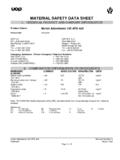Transcription of The Role of Small Gaps Behind Wall Claddings on Drainage ...
1 11th Canadian conference on Building Science and Technology Banff, Alberta, 2007 The Role of Small gaps Behind Wall Claddings on Drainage and Drying John Straube, Civil Engineering Dept & School of Architecture, University of Waterloo Jonathan Smegal, Building Science Consulting, Waterloo, Ont. ABSTRACT A common rain control strategy to help minimize moisture damage is the rain screen wall system. This approach requires a rainscreen, a Drainage plane, flashing, weep holes, and a Drainage gap. Although this approach to rain control is becoming the most common, and is sometimes even mandated by codes and standards, very little research has been undertaken to define the minimum or optimal gap size required for either Drainage or ventilation drying.
2 A test method and experimental program were developed to investigate the gap size required to ensure Drainage , and the role of Small gaps on ventilation drying. Because of the importance of Small geometrical details, full-scale wall systems were tested. The experimental method was able to gravimetrically determine the amount of Drainage , storage and drying during and after a simulated wetting event. The test apparatus and method developed were shown to provide repeatable results over multiple tests as well as in an independent laboratory.
3 The experiments to date have conclusively shown that even Small gaps (less than 1 mm) can drain more water than would normally be found in a Drainage gap. It was also found that in some cases Small gaps will store less water than a large Drainage gap. It was also found that ventilation drying can play a role in very Small gaps of approximately 1 mm, at a pressure difference of only 1 Pa. More research is required to further analyze optimal ventilation gap sizes and compare the laboratory results to hygrothermal modeling.
4 INTRODUCTION Moisture in buildings is one of the leading causes of building enclosure failure. Moisture issues range from cladding staining to serious structural degradation. For moisture damage to occur four factors must combine: moisture availability, a driving force, a path, and a material that is moisture susceptible at the temperature conditions. Moisture damage will only occur when these four conditions are met, and the safe storage capacity of a material is exceeded. Some materials (such as masonry) can store much larger amounts for longer periods of time than other materials (such as paper-faced gypsum wall board) before exceeding their safe storage capacity.
5 It has been recognized for many years that using a drained approach to controlling rain penetration will often provide better control than other strategies such as perfect barrier and mass walls (Ritchie 1961, Lacasse et al 2003). A functional drained wall system comprises a rainscreen (a cladding that acts a screen to rain, sun, impact, fire and more), a Drainage plane (a capillary break that resists inward transmission of liquid water), a flashing system to direct vertically drained water horizontally out, weep or drain holes to allow water to pass back out through the cladding , and a Drainage gap or cavity.
6 The role of the gap is to relieve the potential buildup of hydrostatic pressure due to gravity Drainage of liquid water. If the gap is large enough, airflow through the gap can allow ventilation and drying. If liquid water penetrates the cladding some water will be stored even in a wall system with Drainage . Bulk water can be trapped in depressions in the wall system, or areas that are not 11th Canadian conference on Building Science and Technology Banff, Alberta, 2007 drained properly. Water can also stored on surfaces by surface tension, and absorbed into most building materials by capillarity.
7 Water vapour can also become adsorbed into building materials, or may be present in the air cavities in the enclosure. All of these mechanisms act to ensure that all water that penetrates is not drained. Hence to avoid moisture problems, some drying should be provided. (Straube & Burnett 1998) Depending on the type of storage, several mechanisms are available for drying (Figure 1). Undrained moisture can be removed from the Drainage gap by ventilation or diffusion. Moisture stored in the wall materials may also be able to move to exterior surfaces by capillarity and then be removed by evaporation.
8 Figure 1 : Wall Syste m Drying Me chanisms (Straube & Burne tt 2005) Although a Drainage gap has been accepted as an effective means of handling liquid water penetration through the screen, and ventilation drying shown to be a potentially effective drying mechanism (Straube et al 2004), very little research has been undertaken to define the minimum or optimal gap size required for either Drainage or ventilation drying BACKG ROUND A qualitative investigation of Drainage in Small gaps was previously conducted together with Building Science Corporation (Straube et al 2000).
9 This testing included vinyl siding and stucco on various sheathing membranes. These tests determined the Drainage capability by applying water to the face of the cladding as a spray or poured into the top edge of the wall Behind the cladding . The tests of vinyl siding found that water poured Behind the vinyl siding was caught in the horizontal edges and directed laterally to the j-trim where it drained vertically. It was concluded that significant areas of the Drainage plane were not wetted with either water application method.
10 This conclusion was subsequently visually confirmed when 12 wide x 6 high samples of horizontal vinyl lap siding were tested installed over a transparent plexiglass sheathing. 1. Evaporation of liquid from surfaces 2. Diffusion and convection of vapour 3. Drainage of liquid water through gaps 4. Evaporation and transport by ventilation 11th Canadian conference on Building Science and Technology Banff, Alberta, 2007 The stucco wall assemblies were tested by pouring two litres of water Behind the cladding . It was found that single layers of sheathing membrane bonded to the stucco and hence did not allow good Drainage .

